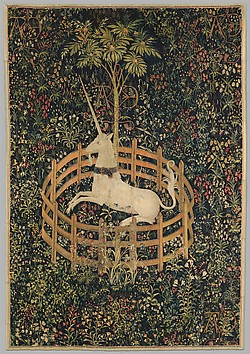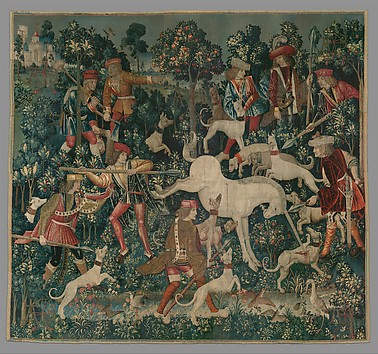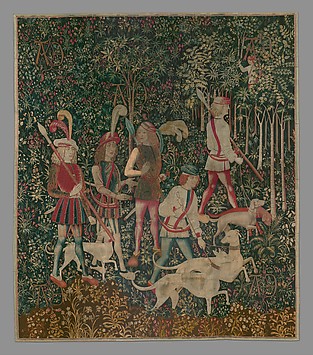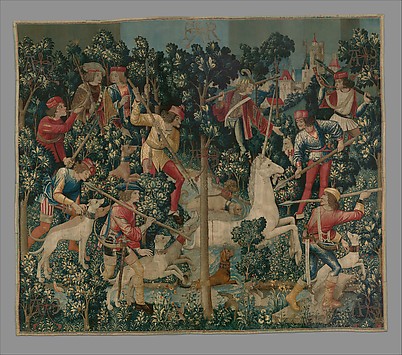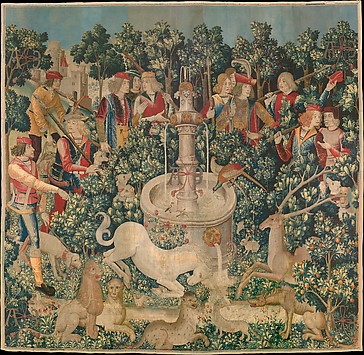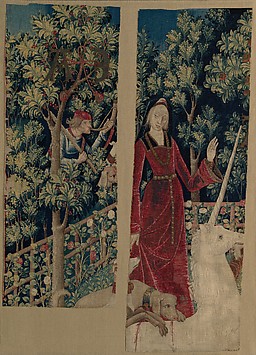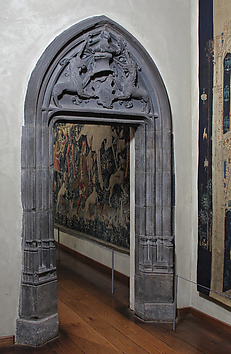On permanent exhibition at The Cloisters, in New York, seven late Gothic tapestries portray the Hunt of the Unicorn. Like the unicorn himself, they are one of the marvels of the world, for in no other work of art anywhere is the pursuit and capture of this magical creature presented in such astonishing detail, with such command of pictorial verisimilitude and symbolic intention. In a duality not rare in the late Middle Ages, the imagery is both secular and religious. The references to love, matrimonial fidelity, and desire for progeny are understandable in an ensemble that may have celebrated a marriage. But the unicorn, at the same time, is Christ, and the compositions reflect the Incarnation, the Passion, and the Resurrection. Gabriel, the angel of the Annunciation, is one of the hunters: the unicorn loses his fierceness in the lap of the Virgin Mary; a thorny crown encircles his horn and neck when he is slain; and then the glorious creature is miraculously alive again and chained to a pomegranate tree, simultaneously an image of the risen Christ and of the lover-bridegroom secured by his adored lady. What patron conceived the extraordinary plan for these hangings, whose earliest record places them in the Paris grande chambre of Duke François VI de La Rochefoucauld in 1680? What artist or artists elaborated the designs to incorporate the many identifiable birds and animals, flowering plants and trees, whose visual charm and implicit meanings make these woven "murals" endlessly fascinating? What workshop, around 1500, had the craftsmen needed to produce such superb hangings? The author, who was a curator at The Cloisters, answers these questions as completely as they may now be answered. In a pleasantly informative style, she conveys all that is known or can be reasonably believed about the commissioning and the manufacture, all that can safely be conjectured about the original owners. The principal indications of the latter are the tapestries' mysterious AE and FR monograms and the small coat of arms that survives when, seemingly, more conspicuous emblems of royalty or nobility long ago disappeared. As for the unknown designers, they are at least partially identified through the author's study of the poses, facial expressions, costumes, and coiffures in the hangings. Illustrating close parallels in Parisian prints and miniature painting of the time, Miss Freeman persuades one that the designers were French or resident in France. The weaving, on the other hand, she narrows to Brussels on the basis of its technical features and high quality. Comprehensive color photography of the tapestries was done especially for this publication, and 44 of the color images are of details essential to the author's discussion, ranging from dramatic figure compositions to studies of the rarer plants. This story of the Hunt of the Unicorn is certain to interest anyone who has visited the tapestries and been struck by their unique beauty. Equally, it should prompt others—unicorn-lovers generally and devotees of medieval art in particular—to look forward to this experience.











